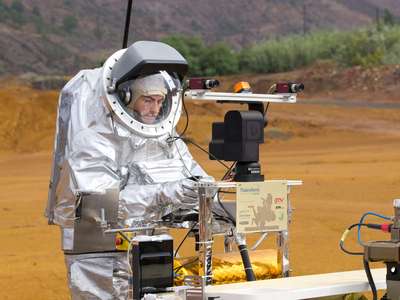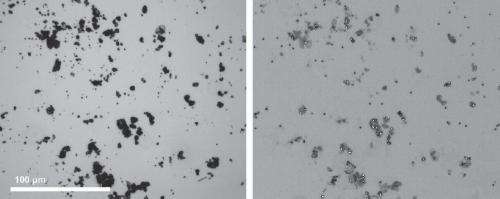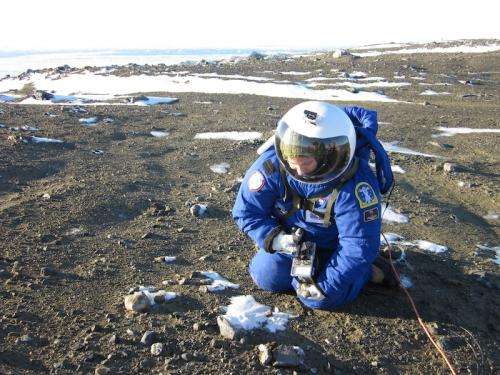Countering contamination for Mars spacesuits

To search for life on Mars, future astronauts would naturally want to step outside their living habitat for a walk. But the spacesuits keeping them alive might also carry Earth microbes or ingredients of life that could contaminate the red planet and complicate the search for extraterrestrial life.
That danger has driven scientists to simulate the contamination risks. Tiny fluorescent tracers stood in for microbes during mock Mars missions with spacesuit simulators in the San Rafael desert of Utah. Simply shining a laser pointer on the spacesuits allowed the researchers to detect levels of contamination based on the fluorescent response.
Such tests may help ensure that contamination risks do not "endanger the entire science of searching for life on Mars," according to Gernot Groemer, president of the Austrian Space Forum and lead researcher on the contamination experiments.
"As long as we have no clue about the potential contamination vectors, we would jeopardize the pristine [quality] of the samples," Groemer said.
Beyond contamination risks, Groemer and his international team also considered how a spacesuit might rid itself of the Martian dust that might carry such contamination. The experiments took place during the Austrian Space Forum's PolAres program that runs from 2007-2012.
Turn on the glow
Scientists have used L.I.F.E. (laser-induced fluorescence emission) techniques to search for microbes locked in the ice of Antarctica. They have also used L.I.F.E. to simulate how rovers might search for organic molecules on Mars during tests in Death Valley, according to Michael Storrie-Lombardi, an astrobiologist who heads the Kinohi Institute in California.

"The technique can be implemented with a laser pointer and an iPhone," Storrie-Lombardi explained. "At present, once the system is calibrated, it takes only a few seconds to process the raw data if the target is an unknown field sample."
But the latest experiments represent the first time L.I.F.E. has simulated possible contamination during a Mars mission with human astronauts.
If the laser pointers reveal a fluorescent glow, pocket digital cameras capture the images and a laptop compares the fluorescent signatures with those belonging to known organic or inorganic molecules. The latest Mars simulations only needed green laser pointers to identify the presence of the tiny bead-like crystals that served as fluorescent tracers.
The method might not only detect "forward" contamination of Mars by Earth material, but also pick up on "backward" contamination of astronauts or their spacesuits by Mars material. The Mars simulations showed that about 60 to 405 bacteria per centimeter squared could gather on a clean spacesuit within minutes.
Bust the dust
Detecting contamination may prove easier than guarding against it. Contaminants can ride along with the Martian dust that would cling to spacesuits due to the electrostatic forces between dust grains. Vibration equipment failed to shake off the tiny dust particles during the Mars simulation.
Instead, future astronauts on Mars might have to step inside an airlock, plug the spacesuit into a high-voltage connector, and push a button. The electric charge could levitate the remaining dust off the suit so that an air jet might blow the dust away like cigarette smoke, Groemer told Astrobiology Magazine.

Such "dust-buster" technology could also have the side benefit of protecting astronauts from breathing in Martian dust inside their living habitat.
Still, scientists worry most about the risk of Earth material contaminating Martian samples.
"The challenge is that if we find something astrobiologically or geochemically stunning on Mars we really have to be sure it is indigenous and not a hitchhiker," Storrie-Lombardi said.
Of robots and spacesuits

Future robotic rovers may use the same fluorescent detection methods to focus on searching for extraterrestrial ingredients of life.
The ExoMars rover, slated for launch in 2018, may carry along a panoramic camera. Several of the camera's filters could detect the fluorescent signatures from the most common polycyclic aromatic hydrocarbons found in Mars meteorites. Such molecules may have served as a key building block for life on Earth.
"We have already published a simulation study for such an experiment and a laser prototype has passed initial ESA engineering review," Storrie-Lombardi said.
Scientists also hope to continue studying possible contamination risks with the Aouda.X spacesuit simulator used in the Mars simulations. The 99-pound (45-kg) suit gives users the sensation of jogging inside a full SCUBA diving suit.
The constant hum of the life support system reminds spacesuit users that they are wearing a "living" machine designed to help keep them alive, according to Groemer.
"You feel like a turtle in its shell; safe and protected against the environment," Groemer said. "And no matter how many EVA (extra-vehicular activity) hours you have experienced, you get the sense of doing something extraordinary with a strong sense of purpose and dedication."
Source: Astrobio.net



















